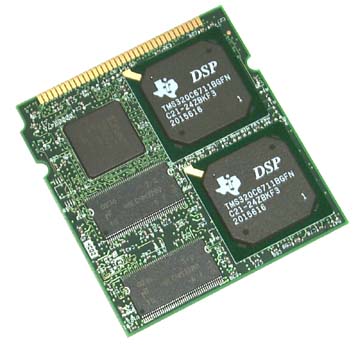SigDM642 Multichannel DSP/Video ModuleNot available as development system or other small quantity. Click here for general-purpose real-time digital and analog video.
Preliminary SigDS642-SODIMM module top and underside outline shown above. Each SigDM642 module contains up to 4 processor-SDRAM pairs (two per side), plus the module contains host interface logic, 2-channel video ADC and DAC, Ethernet PHY interface, and options for both boot/FLASH and cookie EEPROM.
ApplicationsApplications for the SigDM642-SODIMM module include video digitization, DVDs, surveillance and security, PC video, HDTV, video conferencing, VCRs, LCD screens, projectors, and flat panel displays. The modular approach is particularly well suited to providing a scalable solution for high-end consumer electronics, public sector and defense electronics, telecom, and video-over-Internet equipment applications that require a high number of channels and/or image processing such as including popular compression algorithms. AdvantagesSigDM642 modules provide a multiprocessor, highly integrated, low power-consumption DSP solution. The modular approach to multiple DSP processing offers very small form-factor, higher channel density and performance, lower-cost, and several advantages for OEM products:
ProcessorsTexas Instruments C67xx 32-bit floating-point DSP family and DM642 16-bit fixed-point DSP family devices offer high performance, a flexible external memory interface, and a rich set of onchip peripherals. The C6711 and C6713 devices range from 150 to 300 MHz (from 600 to 1350 peak MFLOPS, or 240 to 540 general-purpose code MFLOPS) in processing capability. They offer a complete set of onchip peripherals depending on processor type, including serial ports, host port, PLL, timers, DMA channels, and up to 128k x 32 onchip memory. Cost/performance tradeoff possibilities range from the C6711, an extremely cost effective solution, to higher performance processors, such as the C6713. The DM642 is based on Texas Instruments C64xx fixed-point processor line, and are available in 500 and 600 MHz versions (from 4000 to 4800 peak MIPS). Like the C64xx and C67xx processors, they offer a complete set of onchip peripherals, including specialized video and audio resources. The DM642 has three (3) onchip video ports which provide a glueless interface to common video decoder and encoder Devices, and support multiple resolutions and video format standards. The DM642 onchip video ports include a VCXO Interpolated Control Port (VIC) and support for audio/video synchronization. Algorithm and Codec SupportThe SigDM642 supports Mecoso video DSP algorithms, including MPEG4, WM9, and DIVX. Resolutions supported include QCIF, CIF, and D1; frame rates include 25 and 30 fps. Depending on the video codec, input bitstream rates range from 400 kbps to 2 Mbps. Input formats may be interlaced or progressive frame, output format support includes YUV420 and other formats. Audio I/OCombined with SigDM642 processor modules, the SigSD4 Audio Module offers multichannel 16-bit sigma-delta audio I/O as an integrated component in the modular solution. Audio Module features include:
More information
http://www.signalogic.com/sigsd.htm Boot / FLASH EEPROMThe SigDM642 module contains an optional 4M x 16 boot / FLASH EEPROM that stores boot or program code, configuration and other non-volatile application data. The boot / FLASH EEPROM is optional and should only be installed if required in cost-sensitive applications.a. Host Interface LogicThe SigDM642 module contains PLD logic that multiplexes module edge HPI (Host Port Interface) signals for multiple DSPs and allows one or a combination of DSPs to be accessed simultaneously during host writes (broadcast mode), and individually during host reads. Broadcast mode includes onchip memory block writes, program (COFF) file download, reset, run, and external interrupts. TDM Routing LogicThe SigDM642 module contains PLD logic that allows flexible serial port/TDM routing capabilities. For example, all DSPs can see the same TDM bus, or be routed to separate serial ports at the module edge. Also, DSPs may communicate to each other via high-speed synchronous serial port. This flexibility allows TDM streams to be tailored to fit the natural architecture of the C67xx DSP family and facilitate DSP software development. SigDM642 Development SystemThe SigDM642 Development System allows direct access to multiple DSP devices and multiple SigDM642 modules from several host programming environments under Win9x and WinXP, including C/C++ (MSVC and Borland), MATLABÒ, Visual Basic, and LabVIEW. The SigDM642 Development System is composed of an external board with multiple module sites that connects to the host PC via high-speed interface card. SigDM642 Development System features include:
Note that the SigC6xxx-PC/104 and SigC6xxx-PCI boards may also serve as a development system. The PC/104 card can be used in a PC by means of a "passive carrier" card inserted into an ISA slot. More Information Specifications and Data SheetsSigDM642 Video ADC Video DAC PC/104 Boards IDS™, DirectDSP®, and Hypersignal® software SupportSigDM642 modules, as well as other C62xx and C67xx platforms such as the Texas Instruments DSK C6211 and DSK C6711 boards, are supported by Signalogic off-the-shelf DSP software products designed for DSP-based real-time processing and C6xxx DSP code development, including:
IDS interfaces to the DSP board to provide encoded bitstream file download, display and file capture of DSP algorithm output, continuous display and frame-step display modes, dynamic update of DSP algorithm parameters and monitoring of frame-rate, algorithm statistics and other performance measurements, and a multiple image display area where file based simulations and DSP algorithm output may be compared side-by-side and image operations performed. IDS has the ability to download DSP executables produced by Texas Instruments Code Composer Studio software, and perform symbolic accesses of variables, arrays, and data structures in the DSP algorithm code. IDS accesses and data transfers occur while the DSP code is running, without causing the processor to stop or pause.
Using the DirectDSP software interface, C6xxx processors do not need to be held or otherwise delayed when host software accesses onchip SRAM, and DSP source code does not need to be altered or "instrumented" in any way. The DirectDSP software interface to multiple DSPs is complimentary to JTAG debugging tools such as Code Composer Studio software, and may be used at the same time. DirectDSP software is available under Win9x, Win2k, and Linux. Please call to obtain updated information on driver availability and release status.
|





